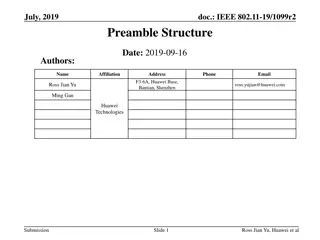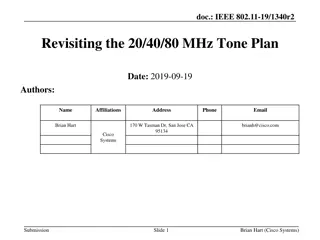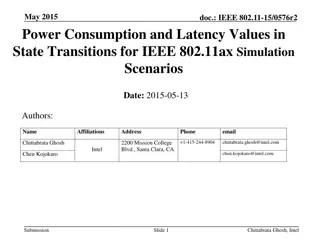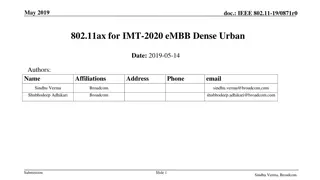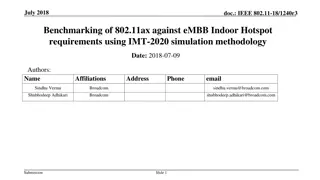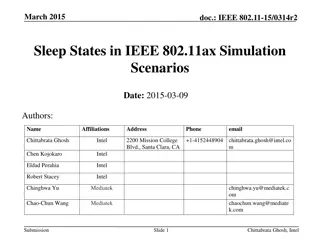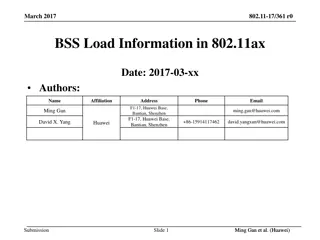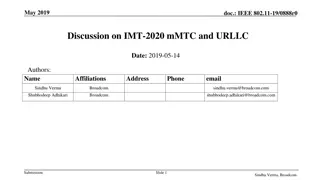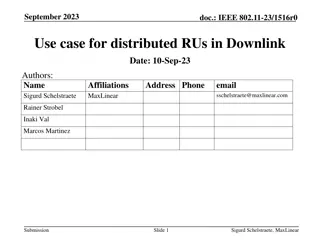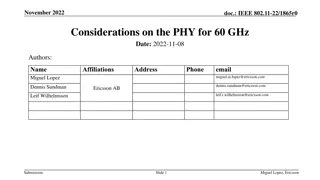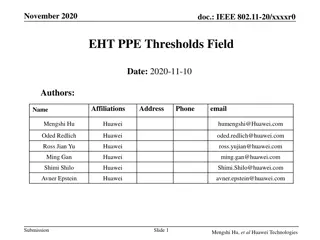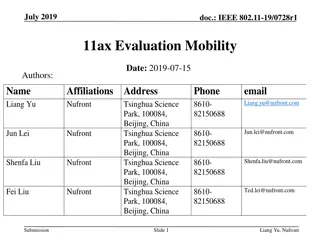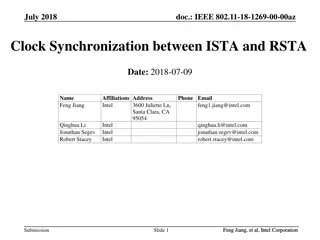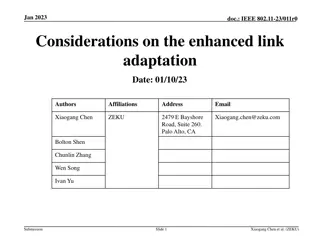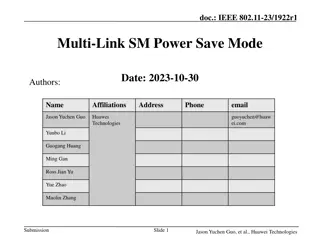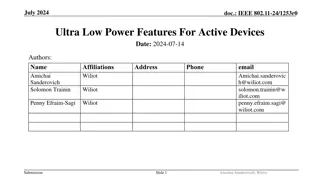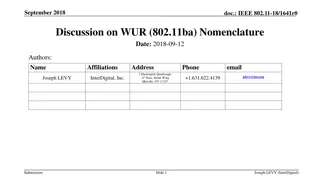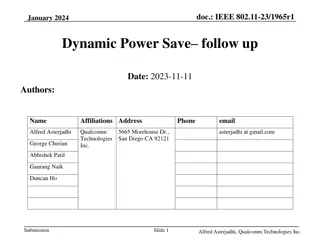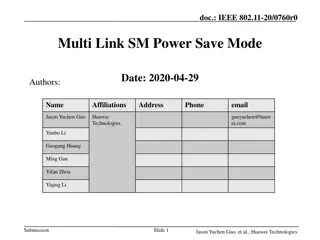Discussion on Power State Definitions in IEEE 802.11ax
This document discusses the power state definitions in IEEE 802.11ax, focusing on Deep Sleep and Shallow Sleep states. It addresses the current consumption values and proposes modifications to enhance the clarity of power state definitions and transitions. The author, Chittabrata Ghosh from Intel, presents specific values for Deep Sleep state consumption and suggests improvements to the existing definitions for better understanding and implementation in simulation scenarios.
Download Presentation

Please find below an Image/Link to download the presentation.
The content on the website is provided AS IS for your information and personal use only. It may not be sold, licensed, or shared on other websites without obtaining consent from the author. Download presentation by click this link. If you encounter any issues during the download, it is possible that the publisher has removed the file from their server.
E N D
Presentation Transcript
September 2015 doc.: IEEE 802.11-15/1100r0 Discussion on Deep and Shallow Sleep States Date: 2015-09-14 Authors: Name Affiliations Intel Address Phone Email Ghosh Chittabrata chittabrata.ghosh@intel.com 2200 Mission College Blvd., Santa Clara, CA, 95054 +1-415-244-8904 Submission Slide 1 Chittabrata Ghosh, Intel
September 2015 doc.: IEEE 802.11-15/1100r0 Abstract The Simulations Scenario document [1] described the common power model parameters in Deep Sleep, Shallow Sleep, Listen, Receive, and Transmit states Current consumption in all the states, except the Deep Sleep state, are well defined for 20MHz, 40MHz, and 80MHz channel bandwidths However, current consumption in Deep Sleep state in either of the channel bandwidths is not defined in [1] In this contribution, we propose specific values for current consumption in Deep Sleep state We also propose to modify the current definition of Deep Sleep and Shallow Sleep states Submission Slide 2 Chittabrata Ghosh, Intel
September 2015 doc.: IEEE 802.11-15/1100r0 Different State Transitions in 802.11ax Chittabrata Ghosh, Intel Submission Slide 3
September 2015 doc.: IEEE 802.11-15/1100r0 Various Power States Definition in [1] Based on contribution [2], the Simulation Scenarios document [1] of IEEE 802.11ax specifies the following common power model parameters for all simulation scenarios Power State parameters Average Current Consumption [mA] Voltage = 1.1V, Band = { 2.4 GHz, 5 GHz }, NSS = { 1 }, Number of TX/RX antennas = { 1 }, TX power per antenna = { 15 dBm } Power State Bandwidth = { 20 MHz } Bandwidth = { 40 MHz } Bandwidth = { 80 MHz } Transmit 280 mA 280 mA 280 mA Receive 100 mA 140 mA 200 mA Listen 50 mA 60 mA 75 mA Shallow Sleep 0.9 mA 0.9 mA 0.9 mA Deep Sleep TBD TBD TBD Submission Slide 4 Chittabrata Ghosh, Intel
September 2015 doc.: IEEE 802.11-15/1100r0 Proposed Current Consumption in Deep Sleep We propose to replace the TBD values for Deep Sleep state in the Simulation Scenarios document [1] of IEEE 802.11ax Power State parameters Average Current Consumption [mA] Voltage = 1.1V, Band = { 2.4 GHz, 5 GHz }, NSS = { 1 }, Number of TX/RX antennas = { 1 }, TX power per antenna = { 15 dBm } Power State Bandwidth = { 20 MHz } Bandwidth = { 40 MHz } Bandwidth = { 80 MHz } Transmit 280 mA 280 mA 280 mA Receive 100 mA 140 mA 200 mA Listen 50 mA 60 mA 75 mA Shallow Sleep 0.9 mA 0.9 mA 0.9 mA Deep Sleep 0.09mA 0.09mA 0.09mA Submission Slide 5 Chittabrata Ghosh, Intel
September 2015 doc.: IEEE 802.11-15/1100r0 Deep and Shallow Sleep State Definition [1] Deep Sleep [2] power state is defined as a sleep state with the least (non-zero) power consumed and the longest transition time to Listen state. Shallow Sleep [2] power state is defined as a sleep state when the STA consumes more power but transitions faster to Listen state when compared to the Deep Sleep power state Proposed modifications to Deep and Shallow Sleep state definition: Deep sleep power state of a wireless module is defined as a sleep state with the wireless radio turned off, i.e., RF, baseband and MAC processors are all switched off. The only power consumed by the wireless module is leakage power. Shallow sleep power state of a wireless module is defined as a sleep state with baseband and MAC processors turned on, but RF is switched off. Submission Slide 6 Chittabrata Ghosh, Intel
September 2015 doc.: IEEE 802.11-15/1100r0 Power and Latency Transitions Among States in IEEE 802.11ax [1, 3] Power Transition parameters Average Power Consumption (mW) State Transitions Transition Time (ms) Transmit Listen TTL=0.01ms 75mW Receive Listen 0.001ms 55mW Listen Transmit TLT = 0.01ms PLT = 100mW Transmit Shallow Sleep TTS=0.01ms PTS = 15mW Receive Shallow Sleep TRS=0.2ms PRS = 15mW Listen Shallow Sleep Listen Deep Sleep Shallow Sleep TLS=0.2ms 0.5 ms (TSL) TLD TSDL = 3ms PLS = 5mW Listen Deep Sleep PDS = 5mW Listen Submission Slide 7 Chittabrata Ghosh, Intel
September 2015 doc.: IEEE 802.11-15/1100r0 Proposed Latency in Transition from Deep Sleep to Listen State in [1] Power Transition parameters Average Power Consumption (mW) State Transitions Transition Time (ms) Transmit Listen TTL=0.01ms 75mW Receive Listen 0.001ms 55mW Listen Transmit TLT = 0.01ms PLT = 100mW Transmit Shallow Sleep TTS=0.01ms PTS = 15mW Receive Shallow Sleep TRS=0.2ms PRS = 15mW Listen Shallow Sleep Listen Deep Sleep Shallow Sleep TLS=0.2ms 0.5 ms (TSL) TLD TSDL = 10ms PLS = 5mW Listen Deep Sleep PDS = 5mW Listen Submission Slide 8 Chittabrata Ghosh, Intel
September 2015 doc.: IEEE 802.11-15/1100r0 Conclusion In this submission, we have proposed current consumption values in Deep Sleep state for 20MHz, 40MHz, and 80MHz channel bandwidths We have also proposed to modify definition of Shallow and Deep Sleep states Finally, we have proposed to modify the latency in transition from Deep Sleep to Listen state Submission Slide 9 Chittabrata Ghosh, Intel
September 2015 doc.: IEEE 802.11-15/1100r0 References [1] S. Merlin et. al., TGax Simulation Scenarios, IEEE 11-14-980r14, July 2015 [2] C. Ghosh et. al., Sleep states in-IEEE 802.11ax Simulation Scenarios, IEEE 11-15-314r2, March 2015 [3] C. Ghosh et. al., Power Consumption and Latency Values in State Transitions for IEEE 802.11ax Simulation Scenarios, IEEE 11-15-0576r0, May 2015 Submission Slide 10 Chittabrata Ghosh, Intel
September 2015 doc.: IEEE 802.11-15/1100r0 Straw poll 1 Do you agree to define the current consumption value in Deep Sleep state in the Simulation Scenarios document as proposed in Slide 5? Submission Slide 11 Chittabrata Ghosh, Intel
September 2015 doc.: IEEE 802.11-15/1100r0 Straw poll 2 Do you agree to include the modified definition for Shallow and Deep Sleep state in the Simulation Scenarios document as discussed in Slide 6? Submission Slide 12 Chittabrata Ghosh, Intel
September 2015 doc.: IEEE 802.11-15/1100r0 Straw poll 3 Do you agree to modify the transition time from Deep Sleep to Listen state in the Simulation Scenarios document as proposed in Slide 8? Submission Slide 13 Chittabrata Ghosh, Intel


